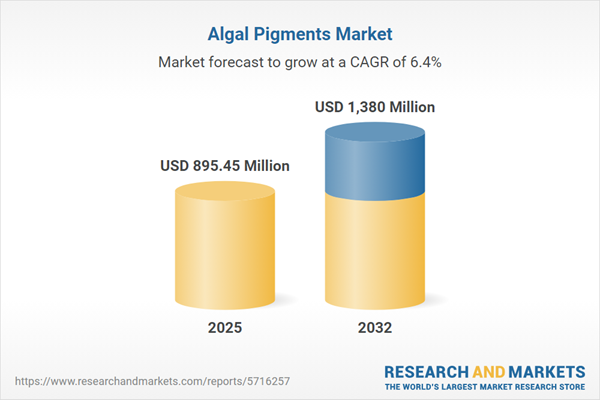Speak directly to the analyst to clarify any post sales queries you may have.
The algal pigments market is rapidly gaining attention from senior decision-makers seeking reliable, sustainable, and traceable alternatives to synthetic colorants. With executive leadership prioritizing clean-label solutions, companies are adapting strategies to align with evolving regulatory and consumer expectations.
Market Snapshot: Algal Pigments Market Size and Growth
The global algal pigments market is expanding steadily as organizations pivot away from traditional synthetic color sources. This transition aligns with intensifying regulatory review and a clear move toward eco-friendly, natural ingredients in key commercial applications. In 2024, the algal pigments market is valued at USD 842.62 million, with projections for continued growth to USD 895.45 million by 2025 and a forecasted reach of USD 1.38 billion by 2032. This translates to a compound annual growth rate (CAGR) of 6.37%. Core drivers fueling this market include responsible supply chain initiatives, rising adoption in food, beverage, and pharmaceutical sectors, and ongoing investments targeting enhanced ingredient quality. Companies strategically invest in advanced production techniques, resilient supply chain models, and agility-focused compliance systems to meet evolving quality standards while fostering stakeholder trust.
Scope & Segmentation: Algal Pigments Market
- Applications: Utilized in animal feed, cosmetics, confectionery, dairy, frozen desserts, functional foods, pharmaceuticals, beverages, and nutraceuticals, algal pigments help companies differentiate their offerings through clean-label and natural ingredient positioning while supporting sector-specific product development.
- Product Types: Including astaxanthin, beta carotene, chlorophyll, lutein, and phycocyanin, these pigment categories meet established safety and efficacy benchmarks while offering coloring and bioactive advantages valued by formulation specialists.
- Sources: Macroalgae and microalgae—such as chlorella, dunaliella, spirulina, and haematococcus—provide flexible sourcing options, promoting alignment with regional sustainability frameworks and supporting supply continuity amid shifting environmental policies.
- Forms: Algal pigments are available as extracts, granules, liquids, and powders, allowing manufacturers to precisely match their production needs, optimize operational efficiency, and respond to varied processing requirements across industries.
- Regions: Adoption spans the Americas, Europe, Middle East, Africa, and Asia-Pacific. Strategic market presence in the United States, Canada, Brazil, the United Kingdom, Germany, France, United Arab Emirates, Saudi Arabia, China, India, Japan, Australia, Indonesia, and South Korea positions enterprises to anticipate regulatory trends and secure geographic diversification.
- Key Companies: Industry leaders such as Koninklijke DSM N.V., Corbion N.V., Cyanotech Corporation, Algatechnologies Ltd., Fuji Chemical Industries Co., Ltd., Earthrise Nutritionals LLC, and Sun Biotechnology Co., Ltd. are prioritizing research, scalable production, and secure supply management to address both competition and regulatory obligations.
Key Takeaways for Senior Decision-Makers
- Enhanced traceability strengthens source transparency and helps companies fulfill compliance requirements while building credibility with both regulators and customers.
- Advances in cultivation and extraction support higher pigment uniformity, which offers a competitive advantage and reliability for diverse industry applications.
- Cross-disciplinary collaboration between cultivation experts and product development teams fosters tailored pigment solutions, thereby enabling companies to address emerging market segments and enhance product differentiation.
- Momentum in regulatory harmonization among global markets is streamlining entry procedures and lowering the compliance threshold in maturing and emerging geographies.
- Comprehensive quality assurance and robust supply chain traceability practices encourage partnership development and underpin expansion into new business domains.
Tariff Impact: Navigating US Supply Chain Changes
Recent adjustments to US tariff policies have prompted organizations to reevaluate sourcing methods in the algal pigments sector. Businesses are adopting nearshore supplier models and flexible trade strategies to bolster supply chain resilience. Implementation of new blending technologies alongside adaptive logistics enables organizations to minimize cost variances and maintain reliable access to key ingredients. This pragmatic approach allows for timely adaptation to dynamic regulatory and economic environments affecting distribution and procurement processes.
Methodology & Data Sources
This analysis is grounded in interviews with senior executives, R&D leaders, and procurement professionals, ensuring actionable coverage of the factors most relevant to industry stakeholders. Findings are corroborated using peer-reviewed research, recent patent evaluations, and authoritative regulatory sources to guarantee suitability for leadership decision-making and strategic planning.
Why This Report Matters
- Supports executive teams in identifying and leveraging growth areas by aligning innovation with bioactive pigment technologies and contemporary sustainability requirements.
- Empowers procurement and operations divisions to enhance compliance, proactively address supply chain risks, and promote organizational stability across established and adjacent markets.
- Delivers targeted, data-driven analysis to inform investment choices and strategic engagement in an evolving pigment technology landscape.
Conclusion
Algal pigments provide organizations with the flexibility to meet regulatory priorities and drive meaningful product innovation. This report equips decision-makers with practical insights to strengthen business strategies within the pigment sector.
Additional Product Information:
- Purchase of this report includes 1 year online access with quarterly updates.
- This report can be updated on request. Please contact our Customer Experience team using the Ask a Question widget on our website.
Table of Contents
3. Executive Summary
4. Market Overview
7. Cumulative Impact of Artificial Intelligence 2025
Companies Mentioned
The companies profiled in this Algal Pigments market report include:- Koninklijke DSM N.V.
- Corbion N.V.
- Cyanotech Corporation
- Algatechnologies Ltd.
- Fuji Chemical Industries Co., Ltd.
- Earthrise Nutritionals LLC
- Sun Biotechnology Co., Ltd.
Table Information
| Report Attribute | Details |
|---|---|
| No. of Pages | 199 |
| Published | October 2025 |
| Forecast Period | 2025 - 2032 |
| Estimated Market Value ( USD | $ 895.45 Million |
| Forecasted Market Value ( USD | $ 1380 Million |
| Compound Annual Growth Rate | 6.3% |
| Regions Covered | Global |
| No. of Companies Mentioned | 8 |









